RM exclusive
A Gathering Storm
Third Annual 2010 Oxygen Market Analysis
- By Joseph Duffy
- Nov 01, 2010
 In an industry being smacked by cuts, caps and competitive bidding, there is no hiding the uncertainty that pervades participants’ perspectives in our third annual Respiratory & Sleep Management Oxygen Market Analysis survey. After 12 months of reported growth by the majority of survey participants, storm clouds are seeping cynicism onto an already fearful industry. Highlights of the good and the bad include:
In an industry being smacked by cuts, caps and competitive bidding, there is no hiding the uncertainty that pervades participants’ perspectives in our third annual Respiratory & Sleep Management Oxygen Market Analysis survey. After 12 months of reported growth by the majority of survey participants, storm clouds are seeping cynicism onto an already fearful industry. Highlights of the good and the bad include:
- 60.4% of respondents said their businesses grew over the last 12 months.
- 62.8% called the 36-month oxygen cap the greatest challenge for their business.
- 54.2% said they would reduce services (45.8% would reduce staff) if they lost in the Round One re-bid.
One respondent’s comments to the survey summarized the feelings of many providers regarding competitive bidding, which takes effect Jan. 1, 2011, in nine of the United States’ largest metropolitan areas:
“We are a very rural area. If competitive bidding goes through, services here will be obliterated. I suspect there will be deaths attributed to non-ability to get oxygen services and equipment. It will be too cumbersome and difficult for most people to go through the many procedures to even get or replenish their supplies and equipment. It will be totally devastating.”
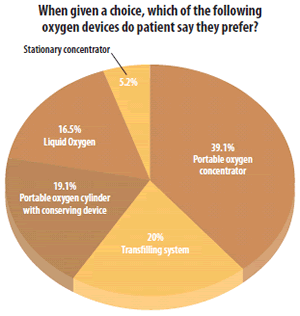
WHO THEY ARE
The primary jobs of our survey-takers broke down this way: respiratory HME business owners (44.4%), respiratory services managers (31.9%), respiratory therapists at a home care company (18.5%) and respiratory therapists at a hospital (5.2%). Most of the respondents (69.3%) have a program to service traveling oxygen patients. They said the following best described their business model for oxygen delivery:
- A mixture of equipment options with emphasis on oxygen cylinder delivery (31.2%).
- Stationary concentrators and oxygen cylinder delivery only (26.8%).
- A mixture of equipment options with emphasis on transfilling systems and/or POCs (24.6%).
- The primary diagnosis of their oxygen patients is COPD (86.5%).
What was the number one factor that influenced our respondents’ current type of business model for oxygen delivery? Fifty percent said cost has highly influenced their business model. Other infl uencers included patient preference and physician order/prescription for specific device.
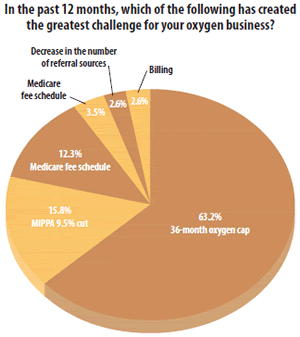
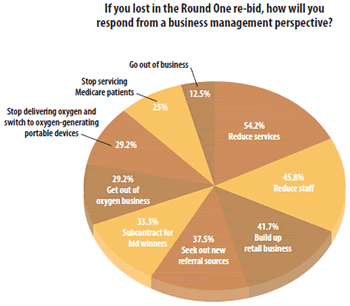
INDUSTRY ILLS
The 36-month oxygen cap provoked 62.8% of survey takers to call it the greatest challenge to their oxygen business. Also, 23.4% of providers responding to our survey said that between 16% and 20% of their oxygen patients would reach the 36-month cap by January 2011. Listed second as a challenge to business was the MIPPA 9.5% cut (15.9%) and third was Medicare fee schedule (12.4%).
So what challenges has the 36-month rental cap created? Respondents’ top three were: maintaining customer service (35.5%), providing oxygen for traveling/relocating patients (22.7%) and delivering equipment/oxygen cylinders (14.5%).
Even with the cuts, caps and competitive bidding, 66.9% of respondents said they are not considering exiting the oxygen business in 2010, compared to 9.3% who said they were considering it, 11 percent who will consider it at a later time and 12.7% who are unsure.
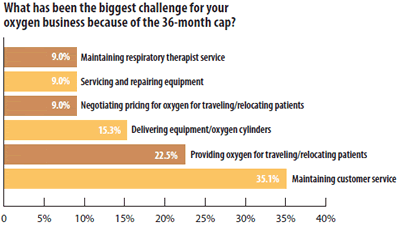
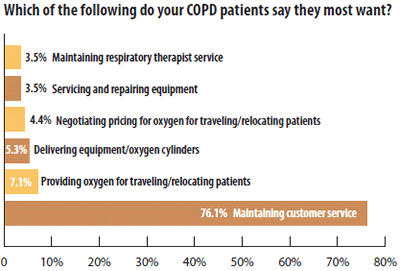
ROUND ONE RE-BID
Obviously, the re-bid of Round One of CMS’s competitive bidding program is at the fore of most providers’ minds, given that for winners, it represents a massive reduction in their funding for oxygen (the 9.5 percent cut from MIPPA, plus the cut from the re-bid); and for losers it means they will be nixed out of their oxygen business in the affected territory altogether.
Moreover, even if a provider isn’t in an Round One CBA, it’s very likely that private payor insurance and other sources funding will look at the new rates under the Round One bids as an indication of how they should trim their funding. No matter how you slice it, the Round One re-bid does not bode well for respiratory providers.
Our survey confirmed that sentiment. When asked, “If you lost in the Round One re-bid, how will you respond from a business management perspective?” survey takers said:
- Reduce services (54.2%).
- Reduce staff (45.8%).
- Build-up retail business (41.7%).
- Seek out new referral sources (37.5%).
- Subcontract for bid winners (33.3%).
- Get out of oxygen business (29.2%).
- Stop delivering oxygen and switch to oxygen-generating portable devices (29.2%).
- Stop servicing Medicare patients (25%)
- Go out of business (12.5%).
WHAT ABOUT PATIENTS?
It all comes down to whether an industry going through tremendous changes can still provide adequate patient care.Part of that may be answered by understanding what patients want. According to respondents, 75.9% of COPD patients would like access to portable technology. And when it comes to a choice of oxygen devices, patients would most like portable oxygen concentrators (39.5%). Increased POC usage would certainly fit the low- to no-delivery business model that could help preserve providers’ businesses.
This article originally appeared in the Respiratory & Sleep Management November 2010 issue of HME Business.
About the Author
Joseph Duffy is a freelance writer and marketing consultant, and a regular contributor to HME Business and DME Pharmacy. He can be reached via e-mail at [email protected].